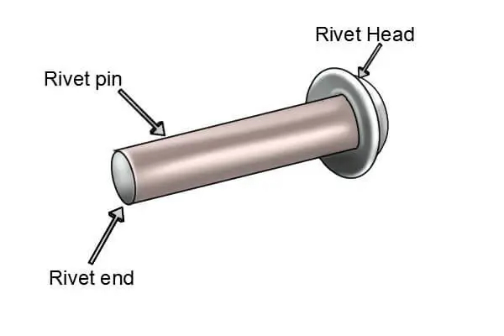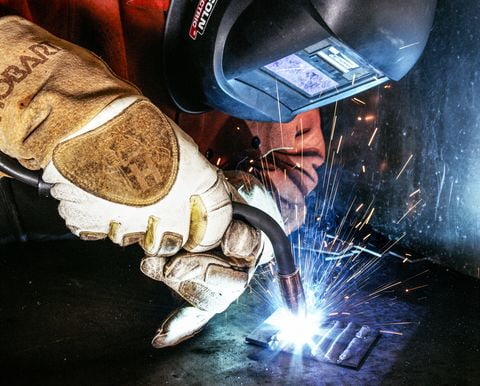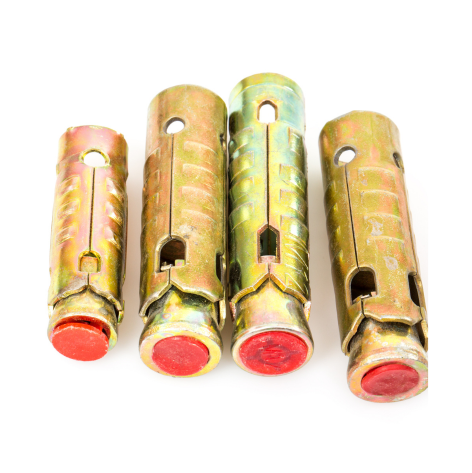Welding and riveting are broadly popular joining processes to fuse two pieces of metal together and they have different applications and traits. Therefore, if you’re designing a part that you need to join to form a complete object, it’s crucial to understand riveting vs welding comparison. This article further does justification to the definition, the pros and cons, and applications of welding and riveting that will help you get stronger and more durable parts. Let’s dive into it.
What is Riveting?

Riveting is a semi-permanent and non-thermal joining method that involves using a mechanical fastener/rivet (a metallic part with a dome-shaped head) to join sheet metal parts.
Riveting involves drilling a hole in the two sheet metal parts you want to join together and installing a rivet. Installation depends on the type of rivets you are working with, as you might have to place, drill, or punch the rivets into the hole.
After installing the rivets in the hole, you have to deform the rivet’s tail. This is achievable by pounding or smashing it. Together with the shaped head, the flattened tail prevents the removal of the rivets.
Types of Riveted Joints
Riveted joints are made by inserting a rivet into a drilled hole in the two sheet metal parts. However, there are three main categories of riveted joints.
Based on Rivets Placement
There are two types of riveted joints based on the placement:
- Lap Joint: You can create a lap joint by overlapping the two sheet metal parts and installing a rivet on the overlapped portion. Lap joints can be single or double, depending on the number of rivets you use.
- Butt Joint: You can create a butt joint by butting up two components together (hence the name butt joints) and using additional material (a cover plate or strap) to bridge them either on one side or both sides. You then rivet the cover plate.
Based on the Number of Cover Plates
Cover plates are materials you place on the workpieces to hold them such that you can drill through them. This category of riveted joints is for butt joints.
- Single Strap Butt Joint: To form a single strap butt joint, place the main plates against each other without overlapping. Then place a cover plate on one side of the main plate and rivet it.
- Double Strap Butt Joint: This is like the single strap butt joint. The only difference is that the two sides have a cover plate. Use two cover plates placed at the opposite side of the two sheet metal parts and rivet each cover plate.
Based on the Arrangement of the Rivets
This category focuses on the arrangement of the rivets you used in joining the sheet metal parts. There are two types:
- Chain Riveted Joint: To form the chain riveted joints, ensure that rows of rivets are exactly opposite each other and in straight lines.
- Zig Zag Riveted Joint: Unlike the chain strap butt joint, the Zig Zag Riveted Joint’s rows of rivets don’t complement each other.
Pros and Cons of Riveting
Riveting is a popular joining method in most sheet metal fabrication services. However, it has its pros and cons.
Pros
- Riveting is a non-heat metal joining method.
- More suitable for dissimilar and non-ferrous metal parts.
- Flexible design.
- It is more efficient and reliable.
- It is easy to perform a quality inspection.
- Disassembling does not lead to damaged riveted parts.
Cons
- High overall cost.
- Increase in overall weight.
- Riveted joints create more noise.
- Corrosion can occur in the riveted area leading to an increase in maintenance cost.
- Due to holes, plates become weak.
What is Welding?

Welding is a thermal process used in joining two similar or dissimilar metal parts. It is a permanent process that involves aligning the metal, melting the metal parts, and cooling them to allow the parts to form rigid joints.
There are many welding processes you can use to join two sheet metal parts together. Here are the popular methods:
Shielded Metal Arc Welding (SMAW)
SMAW or stick welding is a welding technique that involves using a flux-coated electrode connected to a power source to weld the sheet metal parts.
The molten electrode fills the space between the two sheet metal parts to be joined. The flux melts together with the electrode but forms gas and slag, which protect the molten electrode and the electric arc.
Stick welding is a simple, portable, and inexpensive method suitable for welding ferrous materials such as low and high alloy steels, carbon steels, cast iron, and nickel alloy.
Gas Tungsten Arc Welding (GTAW)
Also known as TIG (tungsten inert gas) welding, GTAW is suitable for ferrous or nonferrous metals such as stainless steel, aluminum, and titanium. It involves using a tungsten electrode to melt the workpiece, creating a liquid pool that joins them on solidification.
TIG welding does not use flux, and it requires great precision. However, it produces strong and quality welded joints.
Gas Metal Arc Welding (GMAW)
This technique is the most common welding technique used in welding many materials. Also known as MIG (Metal Inert Gas) welding, GMAW is a semi-automatic or fully automatic method that uses a continuous solid wire electrode (similar to the workpieces) to weld the workpieces together. It is also accompanied by a shielding gas that protects them from contaminants. Unlike other methods, it produces no slap and is continuous.
Flux-cored Arc Welding (FCAW)
Flux-cored arc welding (FCAW) is an outdoor welding process suitable for working with thick and contaminated materials of cast iron, stainless steel, carbon steel, high-nickel alloys, and low-alloy steel origin.
It involves using a continuous hollow wire electrode with a flux compound. It also produces slag, which must be removed to give the welded part a better and cleaner look.
Types of Welded Joints
Welded joints are made by inserting a rivet into the drilled holes of the two sheet metal parts. Common welded joints include:
- Butt Joint Welding: Butt joint welding is the most common and straightforward type of welded joint. It involves placing the metals welded together in the same plane before welding.
- Lap Welding Joints: Lap welding joints are modified butt joints formed by overlapping the sheet metals and welding them together on one or both sides. They are the most suitable welded joints for sheet metals with different thicknesses.
- Tee Joint Welding: Tee welding joints are made by placing the two materials intersect at a 90° angle. One sheet metal part is placed at the center of the other sheet metal part to form a T-shape (hence the name Tee welding joints).
- Corner Joint Welding: Corner joints are similar to Tee welded joints, although the location of the metal is at the corner. This leads to the formation of an L-shape.
Pros and Cons of Welding
Welding is the more popular method when looking at rivets vs welding comparison. However, welding has its pros and cons.
Pros
- Welded joints are solid.
- Suitable for similar and dissimilar materials.
- They are better aesthetically due to forming a smooth appearance.
- There are a variety of shapes and directions to work.
Cons
- They have brittle joints with less fatigue strength.
- Additional stress due to distortion.
- Skilled operatives are required, which may drive up labor cost.
- Requires electricity which may drive up the operational cost.
Differences Between Welding and Riveting

Both welding and riveting offer distinct advantages and disadvantages, making them suitable for a variety of products. However, a crucial difference between the two processes can determine their applicability to specific products. Let’s explore these differences and discuss how to make the appropriate choice between them.
Materials
The two joining processes are suitable for similar and dissimilar materials. However, riveting is the better method if you want to join dissimilar materials. Unlike welding, it does not consider the melting point of the sheet metal parts – an essential part of welding.
Speed
This is a significant difference between riveting and welding. Welding offers higher production efficiency and automation, making it ideal for joining various metal parts. On the other hand, riveting involves multiple processes such as hole drilling, fastening, and flattening of rivets.
Cost
While rivets themselves may have low prices, riveting as a whole tends to be more expensive compared to welding. This is due to the accumulation of material, operational, and labor costs associated with the multiple processes involved in riveting.
Strength
Welding produces a permanent and rigid joint that is stronger than riveted joints. Consequently, they are ideal for joining metals used in making rigid frames. The strength of the joints is a huge difference. Therefore, welding is the better method for products that require such properties.
Safety
Both methods are safe to a certain extent. However, because most welding processes are automated, welding is safer. Another angle would be to consider the use of heat, and here, riveting is the safer choice.
Applications
Riveting is used in the aircraft industry, bridge building, shipbuilding, and consumer product manufacturing. Welding is suitable for making components in the electrical industry, aerospace industry, and defense industry.

Create Your Metal Parts Today!
Discover the perfect solution for your metal parts needs with our expert welding and riveting services. Whether you require robust and permanent welds or versatile and reversible rivets, we have the expertise to deliver outstanding results.
Is Welding Better than Riveting?
The better sheet metal parts joining method depends on what you want. Therefore, instead of looking for a better method, understand the factors that come to play in both methods. Therefore, it is better to go with the question “When to choose to weld or rivet.”
When to Choose Welding
Below are a few conditions you should consider when choosing to weld:
Weight Sensitivity
If you are trying to make a product and are sensitive based on weight, welding is the better option. Unlike riveting, it does not increase the product’s final weight to the extent of riveting as no other materials are added when joining the sheet metal together.
Efficiency
If you value efficiency, welding is also the better joining method to consider. The processes involved are mostly automated, making it faster and easier to join two metals together. Also, there is no need for drilling, making fasteners, etc.
Aesthetics
Welding is the more aesthetically pleasing method as it produces a smooth surface after post-processing. This is unlike riveting, where many people see the bulging of the rivet as aesthetically unappealing.
Strength of the Joint
Welding leads to a permanent and rigid joint that is stronger than riveted joints. Welded joints are strong, durable, and rigid frames. Therefore, they are the better method for making products with strength and rigidity.
Different Shapes
Welding is the more suitable method when working with different shapes. Unlike riveting, you can join together cylindrical metal parts using any of the processes listed above.
When to Choose Riveting
While welding is widely favored in sheet metal fabrication, there are specific scenarios that call for the utilization of riveting. Understanding these conditions can help you make informed decisions when choosing between riveting and welding. Here are a few factors to consider when opting for riveting in sheet metal fabrication.
Types of Materials
When working with dissimilar materials with different melting points, welding might not be the best method since sheet metal fabricators have to consider the melting point. However, riveting is the better method as you only need to drill the material and attach the rivet or fastener.
Heat Requirement
For materials that do not require heat, riveting is the better method. For example, aluminum is not stable thermally, and joining several aluminum sheet metal parts using high heat is mostly not advisable. Therefore, rivets are more suitable for aluminum products, as seen in kitchen utensils.
Disassembling
Riveted products can be disassembled without damage to each part. Therefore, the joining method is suitable for parts that need a further quality inspection or parts that are constantly replaced due to corrosion. This is unlike welding, where the joints are permanent, making it one of the significant advantages of riveting over spot welding in some products.
– Flexible Design
In terms of flexibility, only the top percentile can introduce flexibility when welding. Riveting is the better method for working on a product without losing structural integrity.
Conclusion
There are many sheet metal joining methods for your sheet metal parts. However, the most popular methods are welding and riveting. Both have different processes, advantages, and disadvantages. Consequently, choosing might be a challenge.
While this article introduced the difference between both methods, you may need an expert to advise you on the better method for your project. Therefore, if you have questions surrounding choosing or using welding vs. riveting, you can contact us at RapidDirect and we will give you professional advice.
Moreover, we are a professional sheet metal fabrication service famous for quality and production efficiency at a competitive price. We’re committed to creating the highest quality prototypes and parts with precision manufacturing processes and a dedicated workforce. To get your project started, just upload your design file and get a quote and DfM analysis within hours.
FAQs
Riveting is a semi-permanent joining method used for sheet metal parts. It is semi-permanent because you can unfasten and remove the rivet. This makes riveting the better method for making products that require quality inspection and parts that need constant replacement.
Welding has a higher strength than riveting. Due to the thermal process, welded joints become more rigid and strong. Therefore, welding is more applicable in making products that require high strength and durability.
Generally, riveting is more costly than welding. Even though the rivets used has a low price, the accumulation of cost, e.g., material and labor, increases the overall cost.


